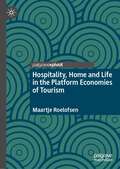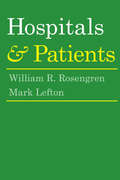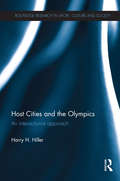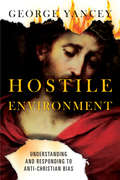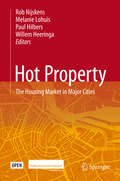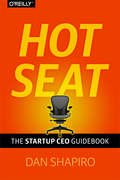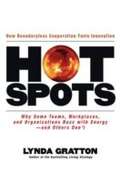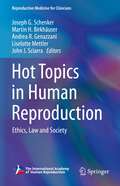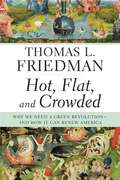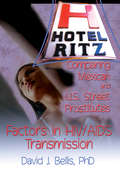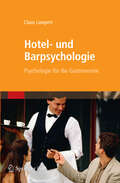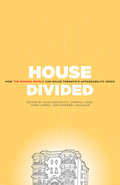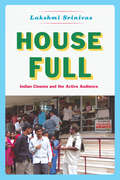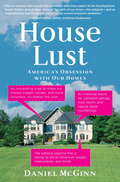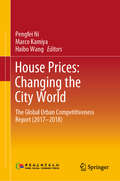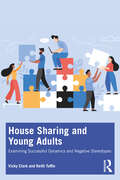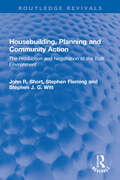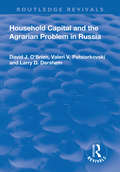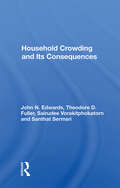- Table View
- List View
Hospitality, Home and Life in the Platform Economies of Tourism
by Maartje RoelofsenThis book explores how digital platforms in the realm of tourism and hospitality have shaped social and material worlds. Based on extensive ethnographic fieldwork with hosts and guests, the book analyses the impacts of platforms on the scale of the city, the home, and the everyday life of individuals. The book first situates platforms within the broader history of digital developments in tourism and questions what is essentially new about these socio-technical formations? The following chapters demonstrate how platforms have affected urban housing, challenged the tourism sector, and transformed understandings of hospitality and home. This is illustrated through a case-study of Airbnb’s development and impact in Sofia, Bulgaria. The final chapters of the book reflect on the political dimensions of datafication processes and digital systems of measurement that underpin the platform’s workings, showing how the platform economies of tourism benefit their users in highly uneven ways.
Hospitals and Patients
by William R. Rosengren Mark LeftonThis book examines the current social crisis in American medicine. The authors, two well-known sociologists, search out-and fi nd-the roots of this crisis in three areas: the organization of the hospital, the attitudes of the hospital toward its patients, and the relationship of hospitals to one another.
Host Cities and the Olympics: An Interactionist Approach (Routledge Research in Sport, Culture and Society)
by Harry H. HillerRather than interpreting the Olympics as primarily a sporting event of international or national significance, this book understands the Games as a civic project for the host city that serves as a catalyst for a variety of urban interests over a period of many years from the bidding phase through the event itself. Traditional Olympic studies have tended to examine the Games from an outsider's perspective or as something experienced through the print media or television. In contrast, the focus presented here is on the dynamics within the host city understood as a community of interacting individuals who encounter the Games in a variety of ways through support, opposition, or even indifference but who have a profound influence on the outcome of the Games as actors and players in the Olympics as a drama. Adopting a symbolic interactionist approach, the book offers a new interpretive model through which to understand the Olympic Games by exploring the relationship between the Games and residents of the host city. Key analytical concepts such as framing, dramaturgy, the public realm, and the symbolic field are introduced and illustrated through empirical research from the Vancouver 2010 Winter Games, and it is shown how social media and shifts in public opinion reflected interaction effects within the city. By filling a clear lacuna in the Olympic Studies canon, this book is important reading for anybody with an interest in the sociology of sport, urban studies, event studies or urban sociology.
Hostile Environment: Understanding and Responding to Anti-Christian Bias
by George Yancey"The only good Christian is a dead Christian." In our heated cultural environment, comments like this are increasingly common. Sometimes Christians are too quick to claim that they are being persecuted. But Christians aren't just being paranoid or alarmist. Anti-Christian hostility is real. Sociologist George Yancey explores the phenomenon of Christianophobia, an intense animosity against Christians and the Christian faith. Among some circles, opposition to Christianity manifests much like other historic prejudices like anti-Semitism or racial discrimination. While Christianophobia in the United States does not typically rise to the violent levels of religious persecution in other parts of the world, Christians are often still treated in ways that perpetuate negative stereotypes and contribute to culture war acrimony. Yancey unpacks the underlying perspectives and root causes of Christianophobia, and he considers to what extent Christians have themselves contributed to anti-Christian hostility. At times, criticisms of Christians are justified, but Christians can confront untruths without capitulation. In this truthful yet hope-filled treatise, Yancey shows how Christians can respond more constructively, defusing tensions and working toward the common good.
Hostile Homes: Violence, Harm and the Marketisation of UK Asylum Housing (Critical Criminological Perspectives)
by Steven A. HirschlerThis book explores the ways in which the state and private security firms contribute to the direct and structural harm of asylum seekers through policies and practices that result in states of perpetual destitution, exclusion, and neglect. By synthesising historic and contemporary public policy, criminological and sociological perspectives, political philosophy, and the direct experiential accounts of asylum seekers living within dispersed accommodation, this text exposes the complex and co-dependent relationship between the state’s social control aims and neoliberal imperatives of market expansion into the immigration control regime. The title borrows from former Home Secretary Theresa May’s pronouncement that the UK government aimed to foster a ‘hostile environment’ in its response to illegal immigration. While the Home Office later attempted to rebrand its hostile environment policy as a ‘compliant environment’, this book illustrates how aggressive approaches toward the management of asylum-seeking populations has effectively extended the hostile environment to those legally present within the UK. Through an examination of the expanded privatisation of dispersed asylum housing and the UK government’s reliance on contracts with private security firms like G4S and Serco, this book explores the lived realities of hostile environments as asylum seekers’ accounts reveal the human costs of marketised asylum accommodation programmes.
Hot Property: The Housing Market in Major Cities
by Paul Hilbers Rob Nijskens Melanie Lohuis Willem HeeringaThis open access book discusses booming housing markets in cities around the globe, and the resulting challenges for policymakers and central banks. Cities are booming everywhere, leading to a growing demand for urban housing. In many cities this demand is out-pacing supply, which causes house prices to soar and increases the pressure on rental markets. These developments are posing major challenges for policymakers, central banks and other authorities responsible for ensuring financial stability, and economic well-being in general.This volume collects views from high-level policymakers and researchers, providing essential insights into these challenges, their impact on society, the economy and financial stability, and possible policy responses. The respective chapters address issues such as the popularity of cities, the question of a credit-fueled housing bubble, the role of housing supply frictions and potential policy solutions. Given its scope, the book offers a revealing read and valuable guide for everyone involved in practical policymaking for housing markets, mortgage credit and financial stability.
Hot Seat: The Startup CEO Guidebook
by Dan ShapiroWhat avoidable problem destroys more young startups than any other?Why is it a mistake to ask for introductions to investors?When do you play the CEO card?Should you sell out?Author and four-time founder/CEO Dan Shapiro tells the stories of dozens of startups whose companies lived and died by the advice in these pages. From inception to destruction and triumph to despair, this rollercoaster read takes aspiring entrepreneurs from the highs of billion-dollar payouts and market-smashing success to the depths of impostor syndrome and bankruptcy.Hot Seat is divided into the five phases of the startup CEO experience:Founding explains how to formulate your idea, allocate equity, and not argue yourself to deathFunding provides the keys to venture capital, angels, and crowdfunding, plus clear advice on which approach to chooseLeadership lays out a path to build a strategy and culture for your team that will survive good times and badManagement reveals how to manage your board, argue with your team, and play the CEO cardEndgame explains how to finish a company's existence with grace, wealth, and minimal litigation
Hot Spots: Why Some Teams, Workplaces, and Organizations Buzz with Energy--and Others Don't
by Lynda GrattonWhat organization wouldn't want to encourage "places and times where cooperation flourishes, thus creating great energy, innovation, productivity and excitement"? This final volume in a trilogy of books on creating energy at work by London Business School professor Gratton (after Living Strategy and The Democratic Enterprise) attempts to analyze the ingredients of positive workplace energy. Gratton details ways to foster a cooperative mindset, remove boundaries between people, give them a sense of purpose and increase their productive capacity, drawing on examples from organizations like BP and Nokia. But despite her interesting and well-organized findings, some readers may find her intensive focus on scientific research too academic, particularly the complicated diagrams and formulae for workplace qualities that are difficult to quantify.-Publishers Weekly
Hot Topics in Human Reproduction: Ethics, Law and Society (Reproductive Medicine for Clinicians #3)
by Andrea R. Genazzani Liselotte Mettler Joseph G. Schenker John J. Sciarra Martin H. BirkhaeuserThis new volume in the Reproductive Medicine for Clinicians series of the International Academy of Human Reproduction (IAHR) focuses on current hot topics in the field, their ethical and legal aspects and their impact on society.It covers topics such as Covid-19, religious and philosophical controversies, possibilities that new technologies offer, human reproductive cloning problems, future challenges related to the heritable gene editing, therapeutic use of stem cells and stem cell factors and the role of receptors in steroids hormone action.This volume also offers an analysis of important innovations and new possibilities such as the use of artificial intelligence in reproductive medicine and the future of prenatal testing. The volume also discusses the issues of pregnancies in advanced paternal age, ethical and legal aspects of gametes donation, sex preselection, surrogate motherhood and infertility in overweight or obese PCOS patients. Chapters on the ethical and legal aspects of fertility preservation in woman, in children with cancer, and in patients sparing treatments in gynecological oncology are also included. This new volume in the series is a valuable resource for gynecologists, obstetricians, endocrinologists, general practitioners and all specialists dealing with reproductive health.
Hot, Flat, and Crowded: Why We Need a Green Revolution - and How It Can Renew America
by Thomas L. FriedmanFriedman shows how the 2 biggest crises of today (America's loss of focus since 9/11 and the global environment crisis) are linked and how we can restore the world and revive America at the same time
Hotel Ritz - Comparing Mexican and U.S. Street Prostitutes: Factors in HIV/AIDS Transmission
by R Dennis Shelby David J BellisExplore ways to reduce the rate of HIV infection in street prostitutes--and the inescapable connection between the heroin trade, prostitution, and HIV!This unique book draws on face-to-face interviews that the author conducted on the streets, with heroin-addicted street prostitutes in Southern California and their counterparts in four large Mexican cities. Author David James Bellis illustrates the significant--and surprising--differences in the risk of exposure to HIV and other STDs that exist between street prostitutes in the two countries arising from national differences in the legality, sociology, and economics of sex work. He points out that Mexican prostitutes, for whom sex work is a simple means of livelihood, are “choir girls” compared with their beaten-up, drug-addicted sisters north of the border who perform sex for drug money and are at much greater risk of HIV and other diseases, like Hepatitis C. This book explores those differences, suggesting new directions for United States prostitution and heroin-control policies--laws currently so interwoven that they reinforce each other, accounting for a deadly circle of crime and disease. In addition to the fascinating results of the author's interviews with 72 female street prostitutes in San Bernardino, California, and 102 more in Tijuana, Cd. Juárez, Cd. Victória, and Cuernavaca regarding their personal sexual, drug, and health practices, and their criminal histories, Hotel Ritz-Comparing Mexican and U.S. Street Prostitutes: Factors in HIV/AIDS Transmission explores: the licensing process for legal prostitutes in Mexico the medical testing that Mexico requires prostitutes to undergo the differences in what United States and Mexican prostitutes know about HIV transmission the difference in condom use between United States and Mexican prostitutes the potential benefits of reforming prostitution and drug laws in both countries the benefits of making methadone maintenence and syringes-and heroin-free for heroin-addicted prostitutes the proportion of United States/Mexican prostitutes who would quit the trade if they learned they had AIDS how the social support system in the United States (housing subsidies, TANF/AFDC money, food stamps, etc.) leads to a greater proportion of drug-addicted prostitutes than are found in Mexico Hotel Ritz-Comparing Mexican and U.S. Street Prostitutes: Factors in HIV/AIDS Transmission also provides you with a look at the hierarchy of female sex workers, an explanation of the etiology of AIDS transmission, and a concise history of heroin and prostitution. Helpful tables and an appendix containing the author's survey questions make the data in this well-referenced book easily understandable.
Hotel- und Barpsychologie
by Claus LampertHotel- und Barpsychologie, was ist denn das? Der Diplom Psychologe und Psychologische Psychotherapeut Claus Lampert stellte als Pionier auf dem Gebiet der Hotel- und Barpsychologie fest, dass sich im Gastronomie Bereich viele Mitarbeiter für psychologische Zusammenhänge interessieren. So vermittelt dieses abbildungsreiche Lehrbuch branchenrelevante fundierte psychologische Grundkenntnisse und bietet zahlreiche praktische und alltagsrelevante Übungen, die dazu anregen, die Sichtweise auf das Arbeitsfeld und sich selbst zu hinterfragen. Dieses Werk ist ein kompaktes Lehrbuch für Auszubildende, sowie ein Begleitbuch für die Fort- und Weiterbildung, wie auch eine faszinierende und spannende Lektüre für alle diejenigen, die ihre Kompetenzen und ihr Wissen in diesem Bereich erweitern wollen.
Hotel- und Barpsychologie: Psychologie für die Gastronomie
by Claus LampertHotel- und Barpsychologie, was ist denn das? Der Diplom Psychologe und Psychologische Psychotherapeut Claus Lampert stellte als Pionier auf dem Gebiet der Hotel- und Barpsychologie fest, dass sich im Gastronomie Bereich viele Mitarbeiter für psychologische Zusammenhänge interessieren. So vermittelt dieses abbildungsreiche Lehrbuch branchenrelevante fundierte psychologische Grundkenntnisse und bietet zahlreiche praktische und alltagsrelevante Übungen, die dazu anregen, die Sichtweise auf das Arbeitsfeld und sich selbst zu hinterfragen. Dieses Werk ist ein kompaktes Lehrbuch für Auszubildende, sowie ein Begleitbuch für die Fort- und Weiterbildung, wie auch eine faszinierende und spannende Lektüre für alle diejenigen, die ihre Kompetenzen und ihr Wissen in diesem Bereich erweitern wollen.
House Church Christianity in China: From Rural Preachers to City Pastors (Global Diversities)
by Jie KangThis book provides a significant new interpretation of China's rapid urbanization by analyzing its impact on the spread of Protestant Christianity in the People's Republic. Demonstrating how the transition from rural to urban churches has led to the creation of nationwide Christian networks, the author focuses on Linyi in Shandong Province. Using her unparalleled access as both an anthropologist and member of the congregation, she presents a much-needed insider's view of the development, organization, operation and transformation of the region's unregistered house churches. Whilst most studies are concerned with the opposition of church and state, this work, by contrast, shows that in Linyi there is no clear-cut distinction between the official TSPM church and house churches. Rather, it is the urbanization of religion that is worthy of note and detailed analysis, an approach which the author also employs in investigating the role played by Christianity in Beijing. What she uncovers is the impact of newly-acquired urban aspirations for material goods, success and status on the reshaping of local Christian beliefs, practices and rites of passage. In doing so, she creates a thought-provoking account of religious life in China that will appeal to social anthropologists, sociologists, theologians and scholars of China and its society.
House Divided
by John Lorinc Alex Bozikovic Cheryll Case Annabel VaughanA citizen's guide to making the big city a place where we can afford to live. Housing is increasingly unattainable in successful global cities, and Toronto is no exception - in part because of zoning that protects "stable" residential neighborhoods with high property values. House Divided is a citizen's guide for changing the way housing can work in big cities. Using Toronto as a case study, this anthology unpacks the affordability crisis and offers innovative ideas for creating housing for all ages and demographic groups. With charts, maps, data, and policy prescriptions, House Divided poses tough questions about the issue that will make or break the global city of the future.
House Full: Indian Cinema and the Active Audience (Fieldwork Encounters and Discoveries)
by Lakshmi SrinivasIndia is the largest producer and consumer of feature films in the world, far outstripping Hollywood in the number of movies released and tickets sold every year. Cinema quite simply dominates Indian popular culture, and has for many decades exerted an influence that extends from clothing trends to music tastes to everyday conversations, which are peppered with dialogue quotes. With House Full, Lakshmi Srinivas takes readers deep into the moviegoing experience in India, showing us what it's actually like to line up for a hot ticket and see a movie in a jam-packed theater with more than a thousand seats. Building her account on countless trips to the cinema and hundreds of hours of conversation with film audiences, fans, and industry insiders, Srinivas brings the moviegoing experience to life, revealing a kind of audience that, far from passively consuming the images on the screen, is actively engaged with them. People talk, shout, whistle, cheer; others sing along, mimic, or dance; at times audiences even bring some of the ritual practices of Hindu worship into the cinema, propitiating the stars onscreen with incense and camphor. The picture Srinivas paints of Indian filmgoing is immersive, fascinating, and deeply empathetic, giving us an unprecedented understanding of the audience's lived experience--an aspect of Indian film studies that has been largely overlooked.
House Lust
by Daniel McginnMcGinn, a national correspondent for Newsweek, combines in-depth reporting and social commentary to explore Americans' obsession with home ownership. Always informative, sometimes funny and sometimes sad, this book examines how shelter as a basic necessity was transformed into an all-consuming passion, which endures even as the housing market melts down. The book includes interviews with homeowners, remodelers, and realtors. It also chronicles the author's decision to further his research by going to real estate school and buying an investment property. Annotation ©2008 Book News, Inc. , Portland, OR (booknews. com)
House Prices: The Global Urban Competitiveness Report (2017–2018)
by Pengfei Ni Marco Kamiya Haibo WangThis report was jointly launched by the National Academy of Economic Strategy of the Chinese Academy of Social Sciences and UN-HABITAT. Using the indicator system and objective data, the competitiveness of 1,035 global cities was evaluated in detail. The report measures the development pattern of global urban competitiveness as a whole, and the gap between the relevant parties and the ideal state. It has refreshed people's past perceptions of urban rankings and confirmed that the science and technology innovation center cities and central cities of emerging economies have begun to break the inherent global cities and they have entered the ranks of the most urban competitiveness.While paying attention to the comparison of competitiveness among cities, this report further promotes the perspective to the pattern and trend change of global economic and social development from the perspective of city. The followings are new findings: First, information technology has increasingly become the primary driving force for urban development; Second, it is the three meridians that divide the global urban population and economic differentiation; Third, the soft links between cities gradually dominate the global urban system; Fourth, the formation of new global cities is beginning.
House Sharing and Young Adults: Examining successful dynamics and negative stereotypes
by Keith Tuffin Vicky ClarkHouse Sharing and Young Adults offers unique insight into the dynamics of successful house sharing among young adults and questions some of the myths fostered by the negative stereotyping of housemates. Illustrated with research from interviews with young adults, it explores co-residence, interpersonal relationships and young people’s development. Beginning with an overview of the concept and history of house sharing among young adults, Clark and Tuffin’s volume also examines the reasons for the lack of research into the area up until recently. It explores key questions, including how young adults choose housemates, what makes a desirable housemate, avoiding complications, the psychological advantages of house sharing, how conflict arises, and the impact of house sharing on adult development. The authors challenge the stigma of shared domesticity, demonstrating the potential of house sharing to enhance well-being through companionship while acknowledging the potential pitfalls caused by tension in intimate settings. House Sharing and Young Adults will be essential reading for both undergraduate and postgraduate students of social psychology, developmental psychology, sociology and anthropology, as well as those interested in group dynamics, housing demographics and discrimination.
House and Street: The Domestic World of Servants and Masters in Nineteenth-century Rio de Janeiro
by Sandra Lauderdale GrahamThe Brazilian women of 19th century worked as housemaids either as slaves or free. House and Street re-creates the working and personal lives of these women.
House of Outrageous Fortune: Fifteen Central Park West, the World's Most Powerful Address
by Michael Gross“Michael Gross’s new book…packs [in] almost as many stories as there are apartments in the building. The Jackie Collins of real estate likes to map expressions of power, money and ego… Even more crammed with billionaires and their exploits than 740 Park” (Penelope Green, The New York Times).With two concierge-staffed lobbies, a walnut-lined library, a lavish screening room, a private sixty-seat restaurant offering residents room service, a health club complete with a seventy-foot swimming pool, penthouses that cost almost $100 million, and a tenant roster that’s a roll call of business page heroes and villains, Fifteen Central Park West is the most outrageously successful, insanely expensive, titanically tycoon-stuffed real estate development of the twenty-first century. In this “stunning” (CNN) and “deliciously detailed” (Booklist, starred review) New York Times bestseller, journalist Michael Gross turns his gimlet eye on the new-money wonderland that’s sprung up on the southwest rim of Central Park. Mixing an absorbing business epic with hilarious social comedy, Gross “takes another gossip-laden bite out of the upper crust” (Sam Roberts, The New York Times), which includes Denzel Washington, Sting, Norman Lear, top executives, and Russian and Chinese oligarchs, to name a few. And he recounts the legendary building’s inspired genesis, costly construction, and the flashy international lifestyle it has brought to a once benighted and socially déclassé Manhattan neighborhood. More than just an apartment building, 15CPW represents a massive paradigm shift in the lifestyle of New York’s rich and famous—and is a bellwether of the city’s changing social and financial landscape.
House of Secrets
by Kevin C. Murphy James MooreThe first novel based on Vampire: The Eternal Struggle collectible card game from Wizards of the Coast. It takes you deep into the World of Darkness, a world where vampires engage in the ultimate struggle for power under the cover of darkness.
Housebuilding, Planning and Community Action: The Production and Negotiation of the Built Environment (Routledge Revivals)
by Stephen Fleming John R. Short Stephen J. WittFirst published in 1986, Housebuilding, Planning and Community Action was written as an examination of the conflicts and tensions resulting from private sector housing growth in Central Berkshire, part of Britain’s ‘Silicon Valley’ along the M4 motorway. The book provides a detailed consideration of the various ‘actors’ and their interactions and explores the fight from Community groups and parish councils to halt development, in opposition to the government’s reluctance to discourage economic growth. It focuses on four groups closely involved in the production, allocation, and consumption of new housing: speculative housebuilders, local planning authorities, parish councils, and community/residents’ groups. The motivations and actions of each group are examined, and the tensions between them are highlighted, set within the context of central government attitudes towards planning and private housebuilding. Housebuilding, Planning and Community Action has lasting relevance for those interested in human geography, and the history of housebuilding and planning.
Household Capital and the Agrarian Problem in Russia
by David J O'Brien Valeri V Patsiorkovski Larry D DershemThis title was first published in 2000: Using micro-level data, this text shows that rural Russian households have made significant adaptations to an emerging market economy in just a few years. It focuses on how household capital (household labour, social networks and comunity attachment) effect the economic and psychological adaptation of households to rapid socioeconomic change. Findings are from 1995 to 1997 panel surveys made in three waves. The book deals systematically with micro-level processes of household adaptation to a market economy, institutional change and emerging informal and formal patterns of land tenure and use in Russia. It shows how structural changes are occurring in rural Russia and their impact on household enterprise development and income. Difference in household capital explains the emergence of inequality in the countryside and differences in the degree to which households experience stress and a higher or lower subjective quality of life.
Household Crowding And Its Consequences
by John EdwardsThis book examines the social and psychological impact of household congestion in the context typical of the developing world on psychological wellbeing, marital and family relations, sibling relations, violence within the family, the impact on marital sex and reproductive behavior.
